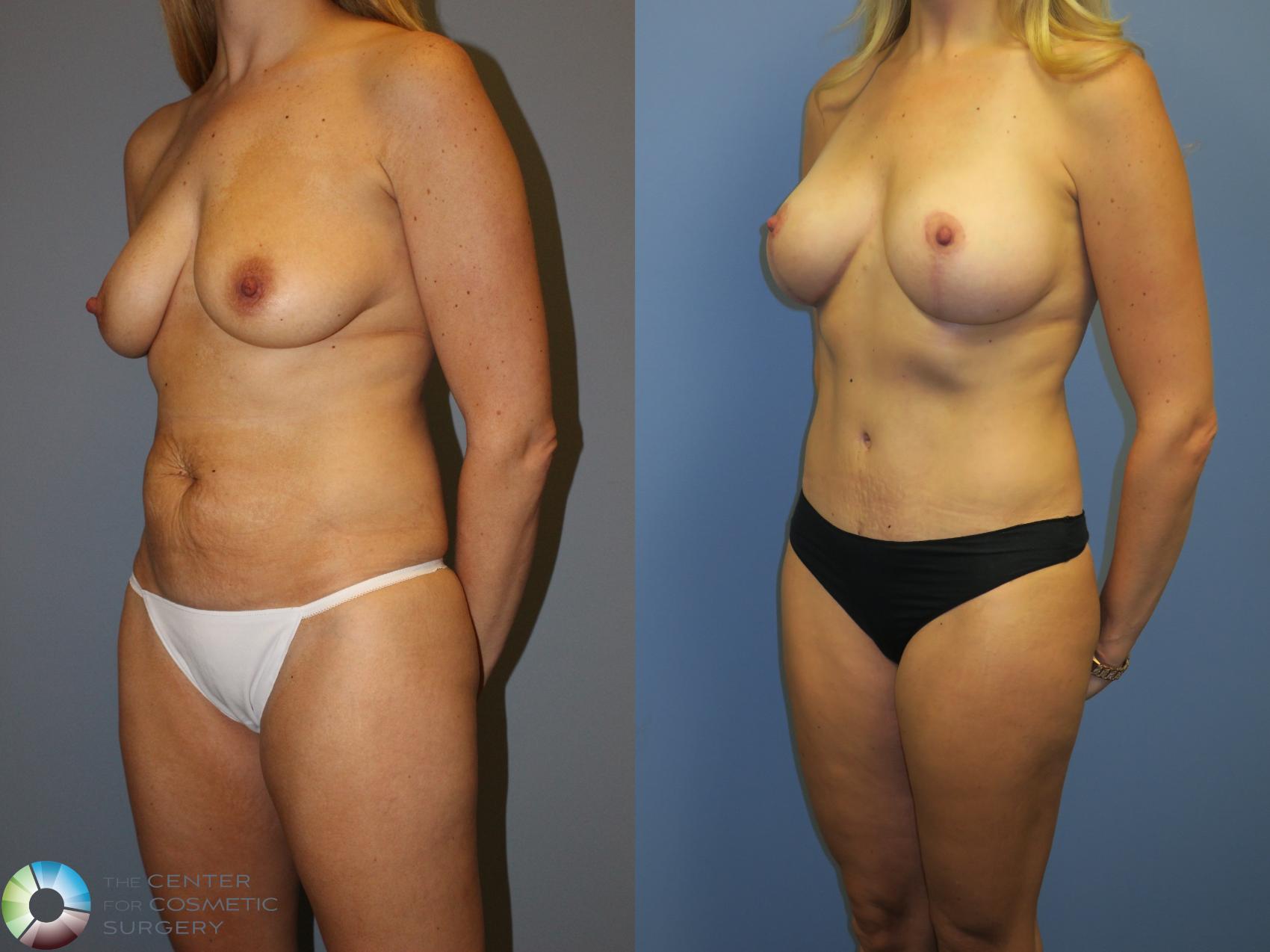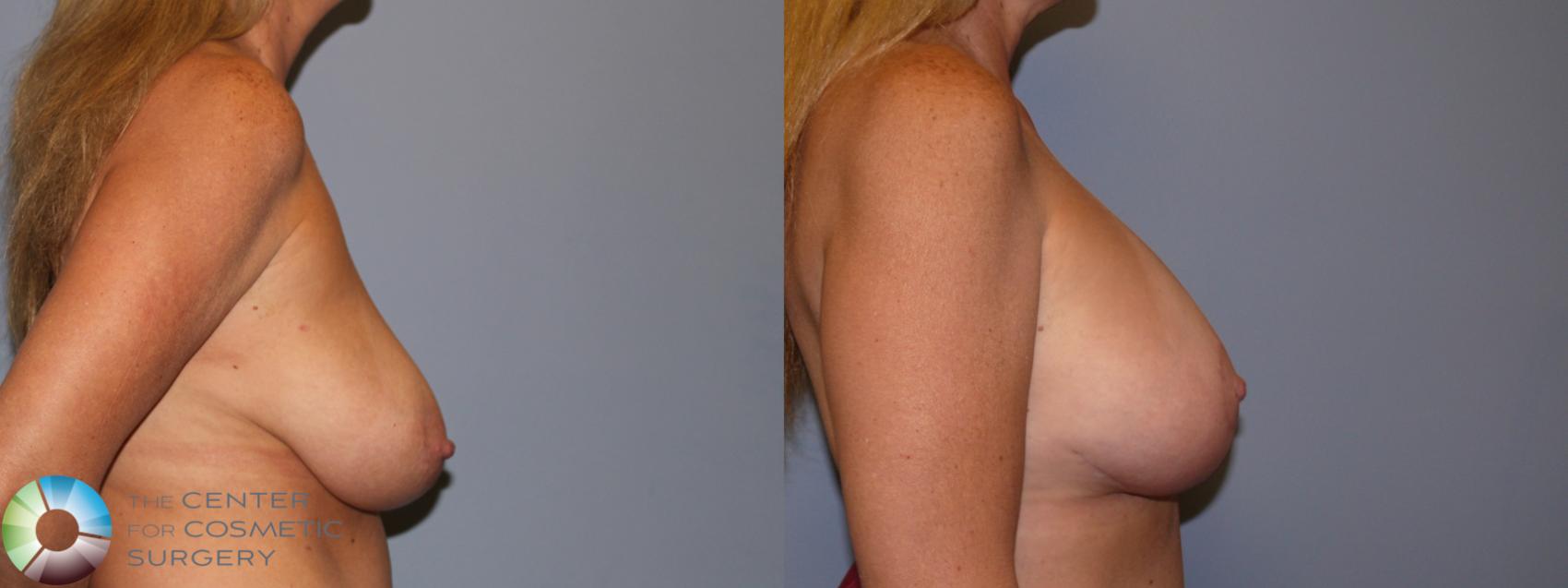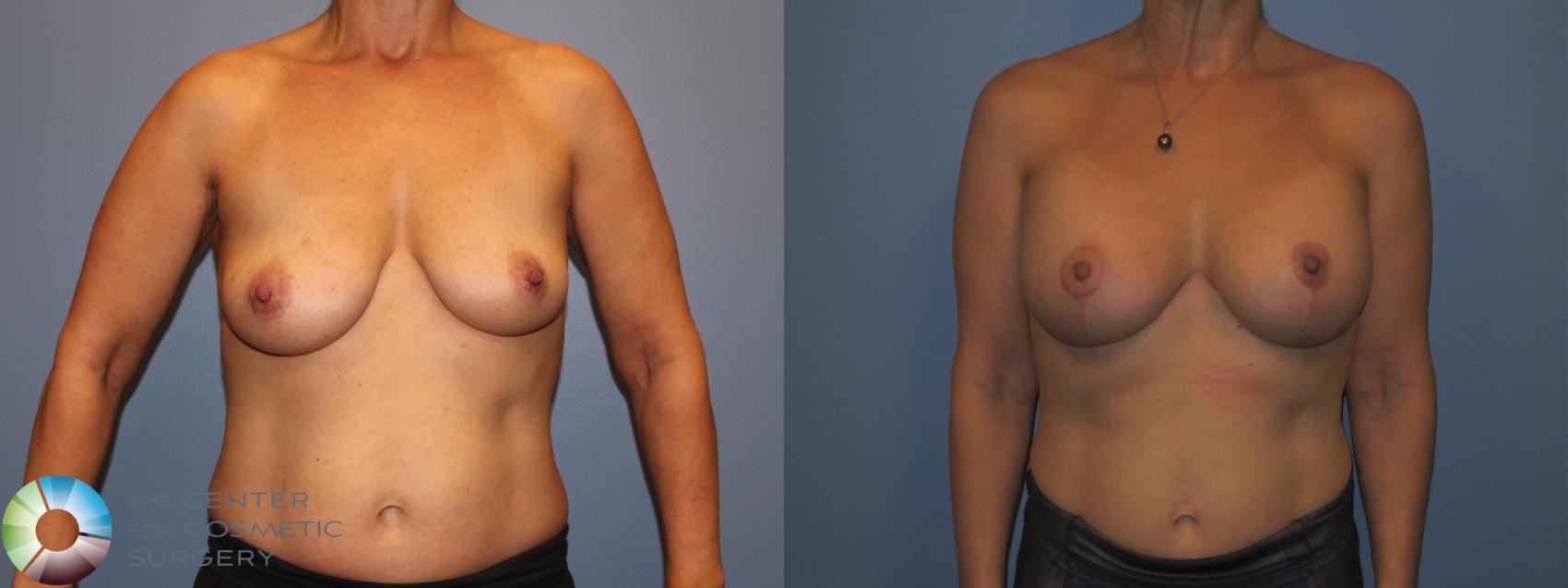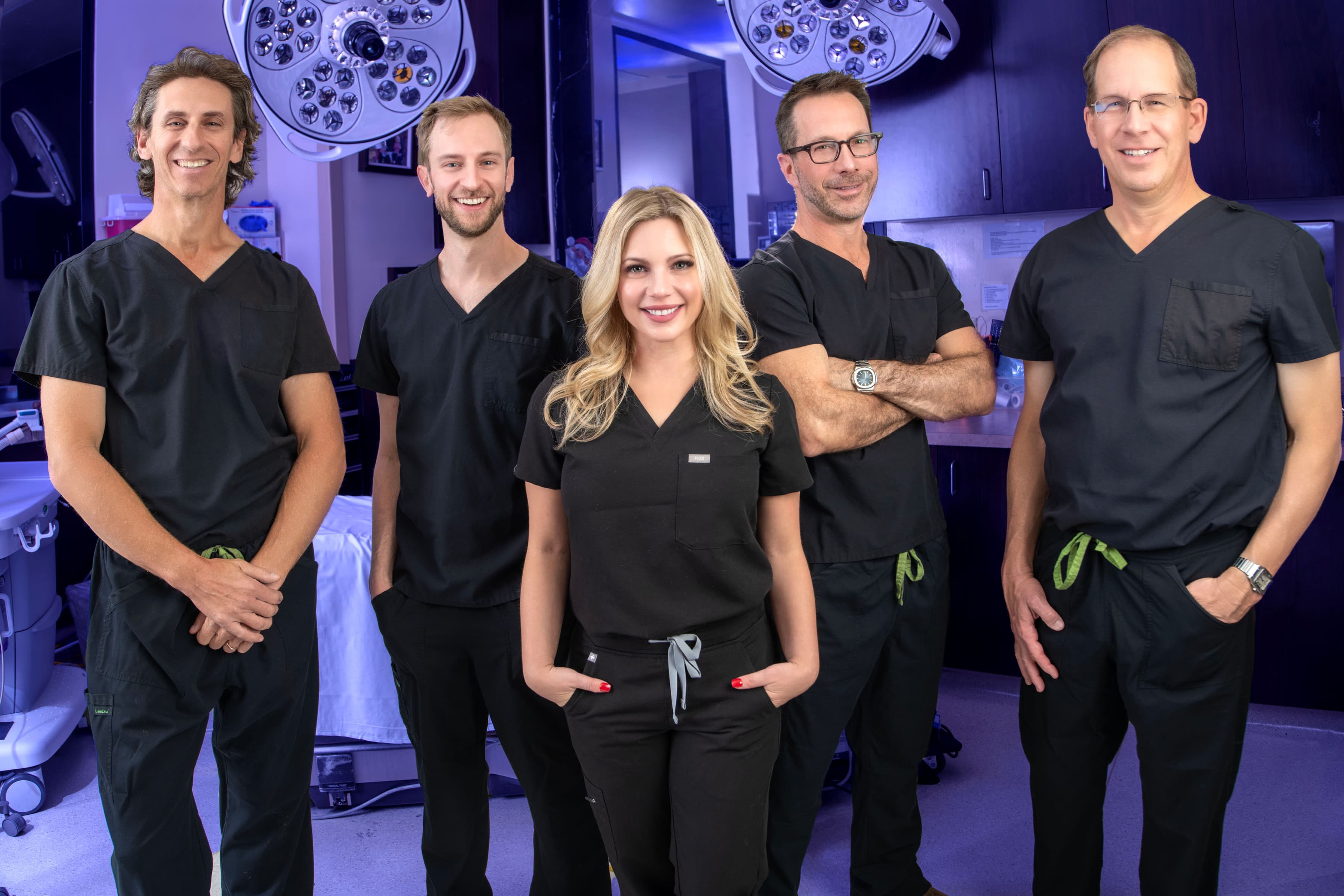The Center for Cosmetic Surgery
725 Heritage Road #100
Golden, CO 80401
Phone: (303) 278-2600
Monday – Friday: 8 a.m.–5 p.m.
The Center for Cosmetic Surgery
755 Heritage Road #100
Golden, CO 80401
Phone: (303) 279-6100
Monday – Friday: 8 a.m.–5 p.m.
The Center for Cosmetic Surgery
501 South Cherry Street #900
Denver, CO 80246
Phone: (303) 951-2100
Monday – Friday: 8 a.m.–5 p.m.
The Center for Cosmetic Surgery
501 South Cherry Street #900
Denver, CO 80246
Phone: (303) 951-2102
Monday – Friday: 8 a.m.–5 p.m.
The Center for Cosmetic Surgery
6985 Tutt Blvd Ste 110
Colorado Springs, CO 80923
Phone: (719) 380-1823
Monday – Friday: 9 a.m.–5 p.m.
Breast Lift in Denver, CO
- 2-2.5 Hour Surgery
- Back to Work: 3-5 Days
When it comes to your breast lift you deserve nothing less than exceptional results. Our breast lift surgeons are renowned in the Denver, Colorado, metro area for delivering beautiful results, outstanding service, and an experience that surpasses your expectations.
Trust Your Breast Lift Surgery to the Experts
Learn why The Center for Cosmetic Surgery is a top destination for breast lift patients from Colorado Springs, Fort Collins, and throughout the Denver metro area:
- Our board-certified plastic surgeons have performed thousands of successful breast lift surgeries
- We use only an accredited, state-of-the-art surgical facility
- We specialize in customized results and the natural-looking Colorado aesthetic
- We take the time to learn about your lifestyle and your goals to ensure your best outcome
- We have hundreds of before-and-after breast lift photos to demonstrate the quality of our work
Our surgeons would be happy to meet with you in person and answer your questions. Simply request a consultation or call our office at (303) 278-2600.
On This Page
What Is a Breast Lift?
A breast lift (mastopexy) involves removing excess skin that causes the breasts to sag. The breast tissue, along with the areolae and nipples, is repositioned higher on the chest, and the lower pole tissues are tightened to support the new, elevated shape.
The underlying breast tissue is stitched together before the incisions are closed to reinforce the lift. In some cases, an areolar lift can be performed, which does not require a vertical scar down the front of the breasts. Our goal is to achieve the best possible shape with minimal scarring, although most of our patients tell us that the resulting scar is a small price to pay for a more youthful, perky breast appearance.
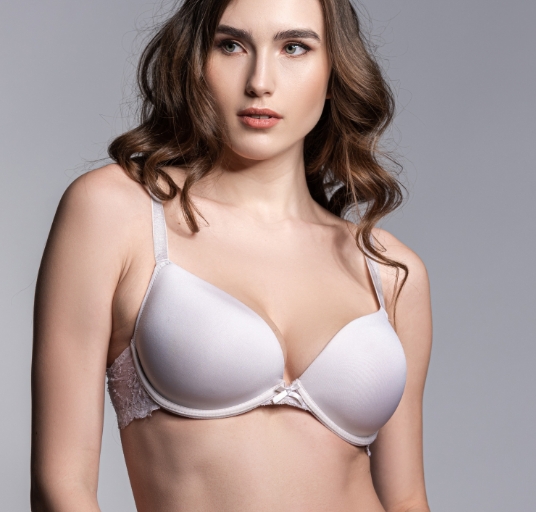
Breast Lift
Before & After Photos
WARNING:
This feature contains nudity. Please click OK to confirm you are at least 18 years of age and are not offended by such material.
Breast Lift Benefits
A breast lift can effectively address sagging and reshape the breasts to achieve a more youthful and aesthetically pleasing look. Here are some key benefits of a breast lift:
- Uplifted, youthful breast contours
- Enhanced nipple position
- Improved breast symmetry
- Expanded clothing and bra options
Many breast lift patients say that the most important benefit is the increased confidence they feel.

Are You a Good Candidate for a Breast Lift?
To determine if you are a good candidate for a breast lift, consider the following factors:
- Ideal candidates have noticeable sagging or drooping of the breasts, often resulting from pregnancy, breastfeeding, weight fluctuations, or aging.
- If your nipples point downward or fall below the breast crease when unsupported, a breast lift can help reposition them to a more youthful height.
- You should be in good overall health, without any medical conditions that could impair healing or increase surgical risks.
- It’s best to be at a stable weight before undergoing a breast lift, as significant weight changes can affect the results.
- Smoking can interfere with the healing process and increase the risk of complications. Non-smokers are better candidates for surgery.
It is important that you have realistic expectations about the outcomes of the surgery and understand the potential risks and benefits.
Breast Lift Techniques
The Center for Cosmetic Surgery offers various breast lift techniques tailored to your needs and desired outcomes. Our breast lift specialists can help you decide which options will work best for you. will guide you in choosing the best method to achieve a youthful, perky breast contour while minimizing visible scarring. These are the primary techniques we use:
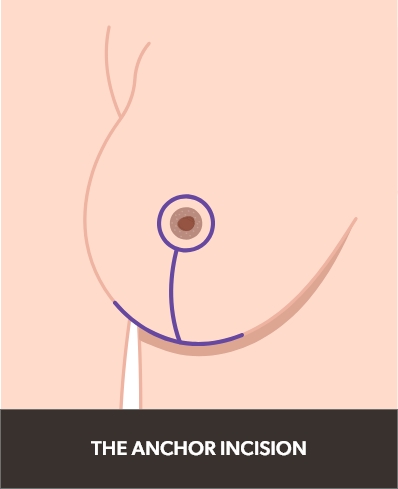
Wise Pattern (Anchor) Mastopexy
The Wise pattern (anchor) mastopexy is a common technique used in breast lift surgeries that require significant skin removal to achieve the best breast shape. This method results in an “anchor” scar and involves two intersecting ellipses with an area above for areolar elevation and in-setting.
Key Features:
- Precise Skin Removal: The amount of skin removed is determined based on the specific needs of each breast.
- Elliptical Excisions: These reduce the vertical and horizontal dimensions of the breast skin, creating a tight, round lower pole – the hallmark of an attractive, perky breast.
- Tissue Tightening: The breast tissue is tightened beneath the skin to support the breast and keep tension off the skin.
Incision Placement:
- Around the Areola: The scar is hidden between the darker and lighter skin tones.
- Horizontal: This scar is concealed in the breast crease.
- Vertical: This scar runs from the lower edge of the areola to the breast crease. Over time, this scar fades and flattens, becoming barely perceptible.
The final scars from the Wise pattern mastopexy are surprisingly inconspicuous, making this technique an effective option for achieving a youthful, perky breast contour with minimal visible scarring.
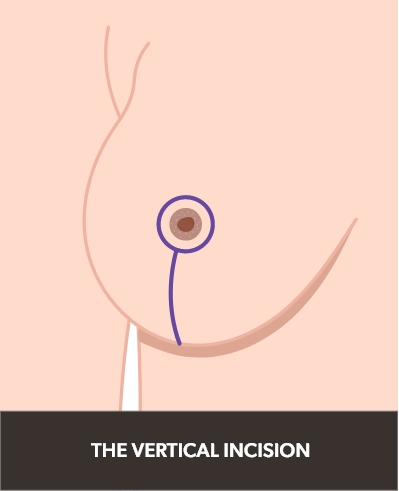
Vertical (Lollipop) Mastopexy
The vertical mastopexy, or lollipop lift, is similar to the Wise pattern mastopexy but omits the horizontal scar in the breast crease. This technique is particularly suitable for smaller breast sizes and can be especially effective when combined with breast implants to restore volume.
Key Features:
- Reduced Scarring: The vertical mastopexy eliminates the horizontal ellipse of skin and resulting scar in the breast crease, resulting in the “lollipop” scar.
- Supportive Suturing: The breast tissue is supported from within by suturing it together in the lower pole beneath the skin.
- Tailor-Tacked Skin: During surgery, the skin is “tailor-tacked” with surgical clips while you are in an upright position. This helps delineate the precise amount of skin removal needed to achieve the best breast shape.
Customization:
- Our surgeons often perform a modified version of the vertical mastopexy. Most of the excision is done with the vertical ellipse, and only a small, additional horizontal elliptical excision is added if necessary.
- The small, additional horizontal scar is usually inconspicuous in the breast crease but can be crucial for completing the perfect, uncompromised breast shape.
The vertical mastopexy provides excellent results with minimal scarring, making it a preferred option for many patients seeking a youthful, perky breast contour.
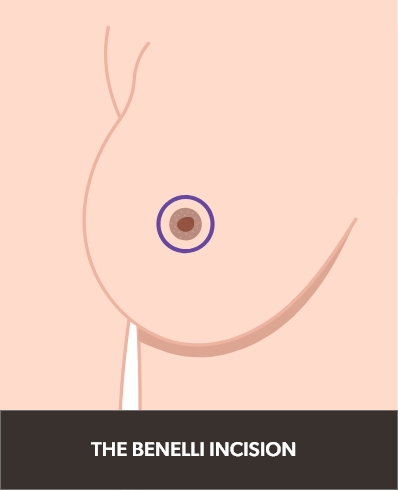
Circumareolar or Benelli (Doughnut) Mastopexy
The circumareolar lift, also known as the Benelli or doughnut mastopexy, primarily focuses on lifting the areola rather than providing a full breast lift. This technique is best suited for specific cases and has distinct limitations.
Key Features:
- Areolar Lift: The circumareolar lift tightens the skin envelope around the areola but does not elevate breasts that sag below the breast crease.
- Suitable Only for Specific Cases: Ideal for patients with low areolar positioning but no significant sagging below the crease. Good candidates typically have tight lower pole breast skin with a short distance between their areolae and breast creases.
- Areolar Symmetry: Often used to even out asymmetrical areolar positions or achieve areolar reduction.
Drawbacks:
- This procedure does not replace a vertical or Wise pattern mastopexy. Using it inappropriately can result in a deformed, unattractive breast shape.
- Misuse of this operation is one of the most common errors in cosmetic breast surgery, often driven by patient demand to avoid vertical scars.
- This approach offers no appreciable lifting for a sagging breast.
- The doughnut mastopexy can slightly flatten the forward projection of the breast.
- This technique may result in scar puckering and irregularity.
While the circumareolar procedure avoids vertical scars, it is crucial to understand its limitations and ensure it is used in appropriate cases to achieve the desired results.
Combining Breast Lift With Other Procedures
Many women combine breast lift with breast augmentation to increase the volume and upper pole fullness of their breasts. Many of our patients combine breast enhancement with liposuction and tummy tuck surgery as part of a Mommy Makeover. Because the nipples and/or areolas often become stretched and enlarged with pregnancy, breastfeeding, and weight gain, nipple and areola reduction is often combined with breast lift surgery. Your surgeon will guide you through your options and let you know if another procedure would complement your goals.
Breast Lift vs. Breast Implants, or Both?
Determining whether you need a breast lift, breast implants, or both can be challenging. The best way to know for sure is to consult with one of the experienced breast surgeons at The Center for Cosmetic Surgery. But in general, a lift serves the purpose of improving lower pole contour—the hallmark of attractive, youthful breasts. An implant does not improve shape but serves two other purposes: to fill out the upper breasts and to increase overall size. If your breasts sag, the lift is critical, while the implant is optional, depending on your goals. If there is no sagging but merely deflation, an implant alone will do the trick.
We provide more detailed information about breast lift vs. breast implants for sagging breasts in this blog post.
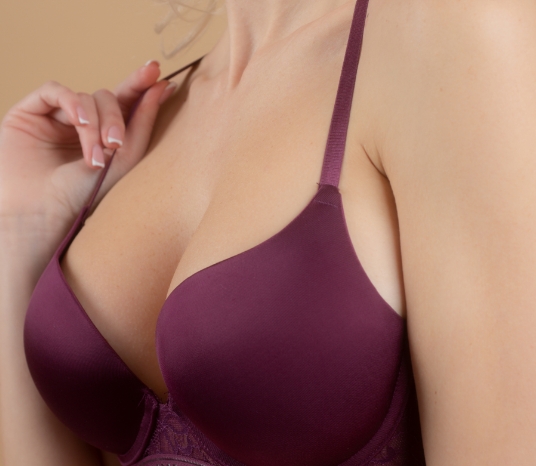
How Long Does It Take To Recover From a Breast Lift?
Recovery from a breast lift varies, but here are some general guidelines to help you understand what to expect:
- First 24 hours post-op: You will go home with your breasts wrapped in gauze and wearing a soft, supportive bra. Soreness, bruising, swelling, and tightness are all normal. You’ll be advised to walk around periodically to maintain good circulation.
- 5 to 7 days post-op: Most patients are ready to return to nonstrenuous jobs and school in 3 to 5 days. Discomfort can be managed with prescription pain medications.
- 2 to 4 weeks post-op: Bruising, swelling, and discomfort improve dramatically in the first 2 weeks. You’ll continue to wear your soft support bra, and you may resume light exercise.
- 4 to 6 weeks post-op: You should feel comfortable and be enjoying your results by this point. Most patients resume vigorous workouts after about 4 to 6 weeks. Your scars will continue to fade for up to a year.
These timelines are general and can vary from patient to patient. Always follow your surgeon’s specific post-operative instructions to ensure a smooth recovery.
OUR EXCEPTIONAL PLASTIC SURGEONS
Board-certified plastic surgeons Dr. Steven Vath, Dr. Andrew Wolfe, Dr. Paul Steinwald, Dr. Matthew Freeman, and Dr. Teresa Cunningham lead our patient-centered practice with warmth, honesty, and respect.
How Long Will the Results of a Breast Lift Last?
The results of a breast lift can last for many years, but factors such as aging, gravity, weight fluctuations, and future pregnancies can affect longevity. Maintaining a stable weight and a healthy lifestyle can help prolong the results.
What Do Breast Lift Scars Look Like?
Breast lift scars are a common concern. The main goal of a breast lift is to achieve a beautiful breast contour. Limiting scarring is a close second to achieving a beautiful shape, and our surgeons strive to minimize scarring while delivering excellent results.
Shape vs. Scars
- Many patients wish to avoid vertical lift scars while achieving a beautiful shape. Unfortunately, removing lower pole skin is usually necessary when breasts sag below the breast crease.
- Once a breast truly sags below the breast crease, skin removal is unavoidable to achieve the desired lift.
How We Minimize Scars
- Our surgeons use advanced techniques to tighten the lower pole breast tissue and keep tension off the skin. This helps scars stay thin and fade significantly over time.
- With time and proper care, the scars usually become barely perceptible, ensuring that your overall breast appearance remains attractive.
Achieving a beautiful breast shape may involve some scarring, but patients consider the results to be well worth it.
Breast Lift FAQs
How much does a breast lift cost in the Denver, CO, area?
The cost of a breast lift varies depending on the technique used, the extent of the surgery, and whether you combine the lift with breast implants. During your consultation, we provide a personalized cost estimate. We also offer Financing options to help the procedure fit into your financial situation.
Can I breastfeed after a breast lift?
Yes, most women can still breastfeed after a breast lift, although it depends on the surgical technique used and the individual’s anatomy. It’s important to discuss your breastfeeding plans with your surgeon during the consultation to determine the best approach for your needs.
Will a breast lift change the size of my breasts?
A breast lift primarily reshapes and elevates the breasts but does not significantly change their size. However, some women perceive a slight reduction in size due to the removal of excess skin and tightening of the breast tissue.
Schedule Your Consultation
If you’re considering a breast lift, we invite you to request a consultation or call our office at (303) 278-2600. Our experienced, board-certified surgeons will assess your needs and goals and help you determine the right approach for you.



